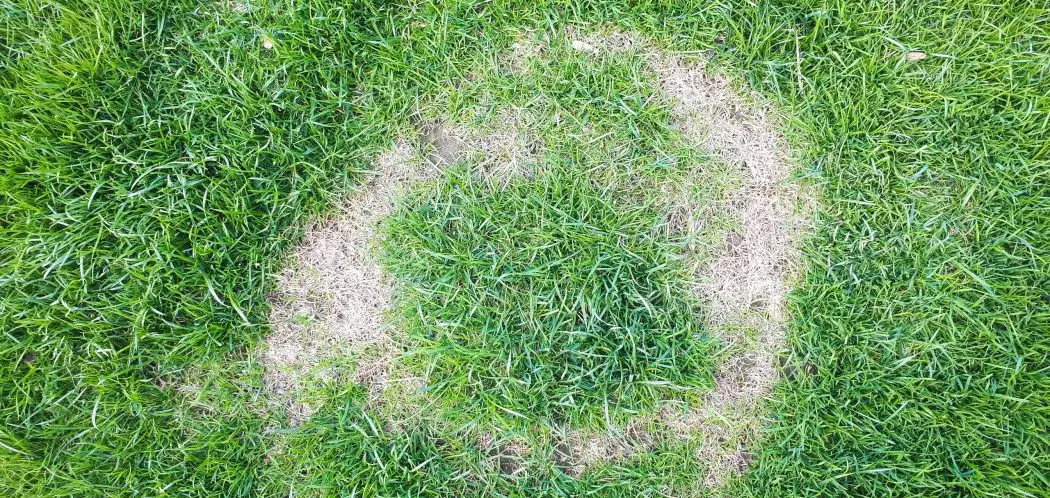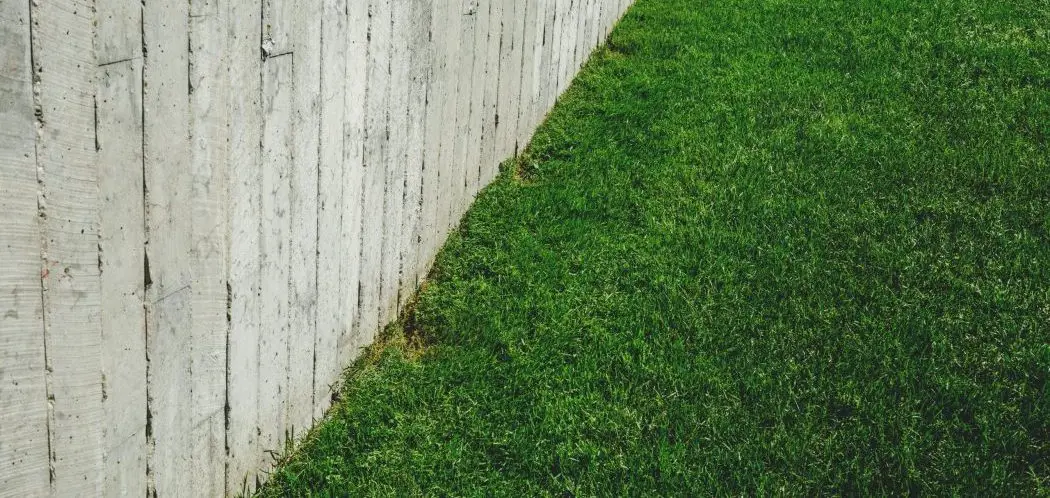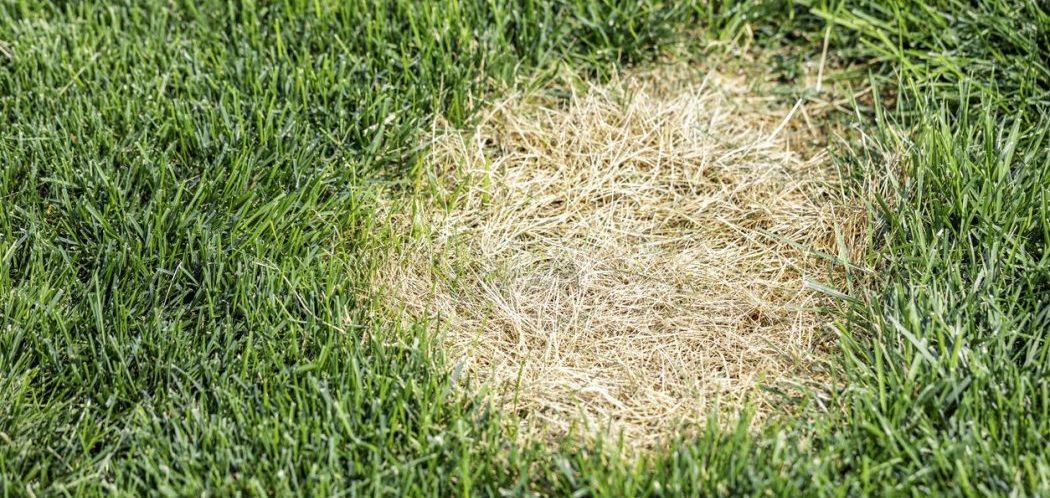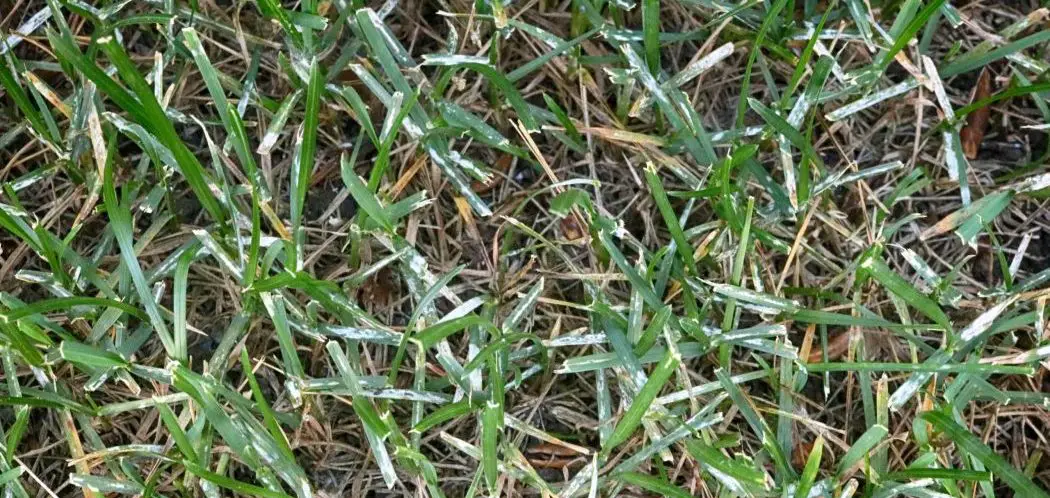Do you have any funky, irregular shapes and patterns in your lawn?
You may have a necrotic ring spot! This is a fungal disease that affects the roots of your grass. It’s sometimes known as frog-eye disease, but the official name is Leptosphaeria korrae.
This is not always easy an easy thing to diagnose, especially if you’ve not seen this kind of thing before.
Identifying Necrotic Ring Spots
In general, if you have a necrotic ring spot you’ll be looking at a horse shoe/circular pattern about four to twelve inches in diameter. These grass spots have a light brown shade surrounded by green center.
Grass with ring spot disease has a very thin root system, so it’s not very resilient. These areas may arise in a smaller section of your lawn before spreading out over a number of years.
They tend to attack the same areas of your lawn each season. The patterns tend to look similar each year, although if you don’t treat this problem, the size of the rings will get bigger and bigger!
The fungus spreads out by spores and mycelia.
When Are You Likely to See a Necrotic Lawn Spot?
NRS can sit dormant for years and years before you ever even see the symptoms in your lawn.
The roots often get affected in the spring, but it’s common to see the effects in the summertime.
You can find NRS all over the US (and the world) but it’s very common to see it in Colorado.
Beware Kentucky Bluegrass!
Kentucky bluegrass is the grass type that is mostly affected. Some others grass types like red fescue and annual bluegrass can also get hit by this disease.
Nercotic Spot Rings are often misidentified as other lawn disease. Some of them are…
- Frog eye fungus
- Summer patch
- Fairy Rings
What Causes Necrotic Ring Spot Fungus?
Fungus is very opportunistic – It has to have the right environment to grow.
More times than not, the fungus arises due to lawn care malpractice resulting in conditions that the fungus can thrive in.
There are two main causes…
Too much water is the likely culprit
Most commonly, a necrotic ring spot is caused by over watering. This could be through rainfall, but its most likely caused by excessive watering over a long period of time. When there’s too much water in the soil, you end up creating an anaerobic environment. The air in the soil is replaced by water which ultimately creates dead soil.
Over use of chemical fertilizers and pesticides
While some of these products can be beneficial to your lawn, applying too much of them can actually contribute to the problem.
Many of the fertilizers available today contain high concentrations of salt like urea and nitrates. These are cheaper per pound of nitrogen, but they also kill the microorganisms in the soil.
What Should You Do About Necrotic Ring Spots?
Luckily, necrotic ring spots are not too hard to fix. Once you improve your soil quality, you should find that the necrotic ring spots will go away and the grass will turn back to normal.
You don’t necessarily need to use any chemicals or fungicides to address the problem.
The best thing you can do is stop the things that are causing the problem in the first place. In any situation, I’d much prefer to address the underlying cause of the symptom than just treating the symptom.
With this idea in mind, stabilizing the soil’s microbiome should be the main focus here. Until you address this issue, the problem will keep returning.
Don’t just tear out the grass and replace it with new sod
A lot of people have this idea and while it may be tempting, it’s important to recognize that it’s not actually the grass the carries the fungus.
The disease lives in the soil, not in the turf. If you tear out the lawn and replace it with new sod, these rings are just going to come back.
Change your irrigation plan
You need to stop overwatering! This is the number one cause of the problem.
It’s usually pretty easy spot a lawn that is holding too much water. The grass may feel swampy underfoot. If you’re not sure, you could also perform a water saturation test so you can see just how much water is getting down into the soil. I use this AMS soil probe (link to Amazon).
I’d recommend performing a sprinkler audit too. You need to see how much water your lawn is getting currently and then adjust it to match the needs of your grass.
In general, aim to give your lawn about an inch of water per week. It’s much better to water your grass deeply and infrequently – no more than a few times per week. This helps to grow a deep root system.
Ideally, we want 6-8” of water saturation.
Now that you’ve stopped over watering the lawn, you should then work building the soils microbiome.
Aerating
One of the best ways you can get air back into the soil is to aerate your lawn.
There are several ways you can go about this, but the best method is to use a core aerator machine. These remove small plugs of soil called cores.
By removing these cores, you’ll reduce soil compaction and allow more air and water to flow better through the dirt.
Avoid quick release fertilizers
It’s good to give your lawn a good slow release food source complete with phosphorus and nitrogen. Try and stay away from quick release fertilizers and urea.
Introduce humates
I’d recommend introducing liquid or granular humates into your mix too. These will help to:
- Break up soil
- Green up your lawn
- Protect against the heat
I recommend this Andersons Humic DG Organic Soil Amendment (link to Amazon).
It’s not toxic and it has a good amount of both humic and fulvic acid.
Avoid applying fertilizers that have an excessive amount of nitrogen
Using an excessive amount of Nitrogen can actually make the disease worse.
It’s recommended that you apply 4lbs or less per season.
There are benefits of using less nitrogen too, some of these are:
- The grass doesn’t grow as fast – You get to mow less often without it growing out of control.
- There is also less variation in the color of your grass. It stays much more consistent.
Overseeding
You can also use grass seed to overseed your turf that’s been affected by necrotic lawn disease.
The best solution is to cover it up with a different type of grass that’s not affected by the disease, e.g. perennial ryegrass.
The perennial ryegrass will blend in nicely with Kentucky bluegrass.
I’d recommend doing this once temperatures cool down in the late summer or early fall.
Before you apply the seed, you’ll want to clear away some of the affected grass, even in the center of the ring spot. To do this, you can either use your hands or a tool to scrape the brown grass off the surface of the soil. It should be pretty easy to do this. The affected grass is not hard to rough up because the root system is weak.
You then want to rough up the soil a little before applying your new seed.
Work the seed down into the soil before covering it with a topsoil mix. I like to use topsoil or peat moss.
Make sure you regularly water your new seed. I’d recommend keeping these areas constantly moist which may require you to water several times per day.
After you have completed your patch repairs, I’d go ahead and overseed the whole lawn. You last thing you want is to have patchy areas that ruin that nice consistent look.
Fungicides
You could use fungicides to manage the problem, although you might find that this isn’t necessary once you have addressed the problems above.
If you do decide to use a fungicide, it’s important to regularly rotate to alternative fungicides. If you use the same type of fungicide, the disease gets used to it and it stops working.
This is known as fungicide resistance
Ideally, you don’t want to use the same fungicide more than twice in a single season.
So, how do you rotate?
You’ll need to base off the class that the fungicide is in.
Each fungicide is given a FRAC code, which you’ll see on the bottle or somewhere on the label.
The FRAC code stands for the fungicide resistance action committee. Basically, they help you to extend the effectiveness of the fungicides. Within each FRAC code is a group of active ingredients which have the potential for cross resistance.
Cross resistance is something you want to avoid so using different fungicides with the same FRAC number is what you want to avoid, hence the need for rotating products.
Here are some of the products I use (links to Amazon):
- Frac Code 1 – Bonide – Infuse Systemic Disease
- Frac Code 3 – Eagle 20EW
- Frac Code 11 – Scotts DiseaseEX Frac Code 11
- Frac Code 11 – Heritage G Frac Code 11
In Summary – An ounce of prevention is worth a pound of cure
Like many problems people have with their lawn, the issues can be addressed through a proper lawn care maintenance routine.
In the case of necrotic ring spots, increasing the porosity and getting better oxygen transfer is key.
This can be achieved by…
- Aerating
- Proper irrigation
- Removing surface debris and thatch
If you really want to be on top of this, you can regularly monitor the ground temperature with a soil thermometer (I use this one). This disease is active when soil temperatures reach 60-63F. You can keep your soil temperature out of this range by proper irrigation. Remember that the soil temperature can vary in different areas of your lawn.
While fungicides can be used, they really aren’t necessary. You should find that once you address the root cause and your soil quality improves, the problem will go away on its own and the grass will begin to repair itself.






